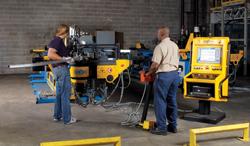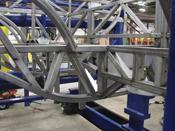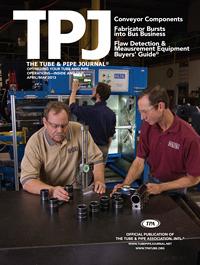- FMA
- The Fabricator
- FABTECH
- Canadian Metalworking
Categories
- Additive Manufacturing
- Aluminum Welding
- Arc Welding
- Assembly and Joining
- Automation and Robotics
- Bending and Forming
- Consumables
- Cutting and Weld Prep
- Electric Vehicles
- En Español
- Finishing
- Hydroforming
- Laser Cutting
- Laser Welding
- Machining
- Manufacturing Software
- Materials Handling
- Metals/Materials
- Oxyfuel Cutting
- Plasma Cutting
- Power Tools
- Punching and Other Holemaking
- Roll Forming
- Safety
- Sawing
- Shearing
- Shop Management
- Testing and Measuring
- Tube and Pipe Fabrication
- Tube and Pipe Production
- Waterjet Cutting
Industry Directory
Webcasts
Podcasts
FAB 40
Advertise
Subscribe
Account Login
Search
CNC tube bender provides precise bends for monocoque frames
Fabricator busts into the bus business
- By Eric Lundin
- April 17, 2013
- Article
- Tube and Pipe Fabrication

A company president and a hands-on type of guy, Sloan MacKarvich (left) learned to run Industrial Laser Solutions’ tube bending machines. His initial investment in CNC bending equipment wasn’t necessary for the company’s existing business, but positioned it for future opportunities.
What would you do if one of your metal suppliers asked you to bid on a contract to provide cut and bent tubing to make monocoque bus frames? If each frame required 2,000 lengths of tube, you might hesitate. If the 700 unique components came from a European supplier, and the part dimensions were specified in metric, and your company had to convert the drawings to inch dimensions, you might pause. If you had a tube bender but had little experience in using it, you might balk. If the material was stainless steel, meaning every bit of scrap would take a bite out of the profit, you’d probably say, “Forget about it.”
Then again, if you enjoyed risks and rewards on a big scale, you just might take on such a project.
Carts Before Horses
Sloan MacKarvich, president of Industrial Laser Solutions (ILS), Atlanta, faced this dilemma a couple of years back, shortly after the financial crisis tore through the economy, leaving little but devastation in its wake. Like many manufacturers, ILS had more than a few idle machines, and the company was looking for a way to put them to work. ILS isn’t a conventional job shop by any stretch of the imagination, so it looked for work that suited its niche.
“First and foremost, this is an engineering company,” MacKarvich said. The company is an outgrowth of Tie Down Engineering Inc., founded decades ago to design and manufacture anchors and foundations for mobile homes. From there the company branched out. It was located in the Miami area, so anchoring systems for boats were a natural fit. It later developed a trailer business, making axles, running gear, and entire trailers for boats and other uses. It also developed a line of hardware for roofing systems. Although the company incorporates some sourced components in its products, for the most part it designs and develops its products from scratch.
The company had done some tube bending using a Pines #2 and a bender it developed in-house, but its trailers never required a big variety of bends, so it hadn’t developed much in the way of bending expertise. On the other hand, one of the company’s main assets was MacKarvich’s interest in pursuing new technologies. For example, while it was accustomed to using a plasma table to cut sheet metal parts in the early 1990s, MacKarvich decided to invest in a laser cutting machine in 1994. It didn’t have an immediate need for laser cutting at the time, but MacKarvich would rather buy a machine, learn how to use it, and incorporate it into the company’s work flow gradually. Likewise, Mac-Karvich had seen a CNC tube bender at the FABTECH® expo in Atlanta in 2006 and, speculating on the possibilities, made the investment. The company didn’t have an immediate need for the bender, which sounds a bit like putting the cart before the horse, but it works for ILS.
Hustling for Buses
The bus project sounded more than a little daunting. ILS wouldn’t have to build the bus frames, but it would have to do everything possible to make sure every piece was converted accurately, cut to the right length, bent to necessary dimensions, labeled appropriately, and shipped on time (see Figure 1).
The first step, converting all the parts to inch dimensions, would have been impossible for most small fabrication shops to complete in a timely manner.
“We had five degreed engineers assigned to work up the drawings, making solid models, coming up with the cut lengths, and everything else,” MacKarvich said. “It was a monumental effort.”
ILS took on the job, and it was progressing as planned, but the metal supplier figured it needed some assurance that ILS would be able to bend the parts accurately. The big day came when the customer’s representative asked for a demonstration of ILS’s bending capabilities.
“We had no idea how to run it,” MacKarvich said.

Figure 1: Industrial Laser Solutions’ first big CNC bending project was a monocoque bus frame. It consisted of 700 unique parts that, when combined, would constitute a 2,000-piece, 3-D jigsaw puzzle.
Some of the ILS staff scrambled to learn how to run the machine to make a few parts and let the customer know they were up to the task (see lead photo). Eventually they learned the ins and outs of bending, and got a more thorough understanding of what the bender could do. The machine, a Star Bend 550, handles mild steel tube up to 2¼ in. diameter by 1⁄8 in. wall thickness. Accustomed to dimensional accuracy of ± 1⁄16 in. when using its other equipment, ILS was told the new machine would make parts to half that tolerance, which was one of the chief reasons MacKarvich invested in it in the first place.
Eventually the company bought a second machine, the 800 model, and even sent some of its staff to Italy with some lengths of tubing—3 by 1½ in., 11 gauge, and 4 by 1½, 11 ga.—to make some test bends. The material was 304 stainless, and the main question was whether the machine would have enough power to make and repeat accurate multiradius push bends (see Figure 2 and Figure 3). Not only do the two models provides enough power, but they are capable of interpolation bending, the process of bending a tube to varying radii on-the-fly. This capability wasn’t just a frill, it was necessary for this project.
“We make a bumper piece at the front of the bus,” MacKarvich said. “Across the front of the bus, it has a really gentle bend—a long, sweeping bend—but this transitions to a really sharp radius where it wraps around the bus.”
Clearing a Few Hurdles
The ILS staff learned that bending tube or pipe accurately and consistently requires a combination of knowledge, experience, intuition, and patience. Depending on the project, quite a bit of patience.
One of the first challenges it faced was making accurate bends. A few test bends is one thing; accuracy in the high volume needed for a project of this scope is something else altogether. Tube bending isn’t the black art many say it is, but sometimes an experienced technician is needed to tweak the bending program.
“The applications engineer for Innovative Tube Equipment, Franco De Iuliis, spent some time on-site teaching us how to dial everything in,” MacKarvich said.
A few more difficulties awaited.
“We discovered that consistency is tricky,” MacKarvich said. This had nothing to do with the bender, and everything to do with the material.
“We’d break a bundle and find that we had material from several heats,” he said. Using one bending program on tube from several heats usually results in bend variations. Some fabricators segregate the heats, but ILS took a different approach.
“We use a three-roll bender to tweak the bends,” MacKarvich said. “When you do this, you’re not so much a fabricator, but a craftsman. It’s a different skill, but one we had to develop to prevent scrapping a lot of tube.”

Figure 2: Accuracy and repeatability go hand-in-hand. When the tubing is consistent—one heat and one weld seam location—CNC benders provide consistent parts.
ILS also noticed that the weld seam wasn’t consistent from one lot to the next. Because even the large, sweeping bends require a mandrel, and the mandrel has a relief on one side for the weld bead, ILS’s tool and die staff would cut a new relief on another side of the mandrel. This helped to delay the expense of additional mandrels, but each mandrel is limited to four reliefs. Eventually they ran out of sides and had to buy a additional mandrels to handle more weld seam locations.
An off-center weld seam also wreaks havoc on bend consistency. The weld seam’s hardness is different from that of the parent material. When the weld seam is centered, the bends are consistent, but when the weld seam is off-center, the material reacts differently.
“It’s similar to applying a torque force,” MacKarvich said. “The bending force induces a twist in the material. Some of these bends were big, sweeping bends, with 600- and 700-in. radii. It’s easy to twist a piece like that.” The ILS staff got around that by purposely indexing the tube 1 to 2 degrees in the other direction.
The staff also found that they had to be careful how they programmed the bender.
“We’d run a test bend on a part with two bends, one gentle, sweeping bend and one tight bend, and find that the tight bend was off a bit, and apply a correction. The bender would apply that correction to the entire piece, changing every radius,” he said. This didn’t pose a big problem, though, and it was just a matter of learning how to apply the correction only where it was needed.
Despite a few difficulties, ILS is happy with the bender because in the end, it did what it was intended to do.
“We never had to shut down production, and we never had a supply disruption,” MacKarvich said.
About the Author

Eric Lundin
2135 Point Blvd
Elgin, IL 60123
815-227-8262
Eric Lundin worked on The Tube & Pipe Journal from 2000 to 2022.
About the Publication
Related Companies
subscribe now

The Tube and Pipe Journal became the first magazine dedicated to serving the metal tube and pipe industry in 1990. Today, it remains the only North American publication devoted to this industry, and it has become the most trusted source of information for tube and pipe professionals.
start your free subscription- Stay connected from anywhere

Easily access valuable industry resources now with full access to the digital edition of The Fabricator.

Easily access valuable industry resources now with full access to the digital edition of The Welder.

Easily access valuable industry resources now with full access to the digital edition of The Tube and Pipe Journal.
- Podcasting
- Podcast:
- The Fabricator Podcast
- Published:
- 04/16/2024
- Running Time:
- 63:29
In this episode of The Fabricator Podcast, Caleb Chamberlain, co-founder and CEO of OSH Cut, discusses his company’s...
- Trending Articles
Team Industries names director of advanced technology and manufacturing

Orbital tube welding webinar to be held April 23

Chain hoist offers 60-ft. remote control range

Push-feeding saw station cuts nonferrous metals

Corrosion-inhibiting coating can be peeled off after use

- Industry Events
16th Annual Safety Conference
- April 30 - May 1, 2024
- Elgin,
Pipe and Tube Conference
- May 21 - 22, 2024
- Omaha, NE
World-Class Roll Forming Workshop
- June 5 - 6, 2024
- Louisville, KY
Advanced Laser Application Workshop
- June 25 - 27, 2024
- Novi, MI



























